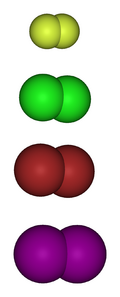Halogen
| Group | 17 |
|---|---|
| Period | |
| 2 | Template:Element cell |
| 3 | Template:Element cell |
| 4 | Template:Element cell |
| 5 | Template:Element cell |
| 6 | Template:Element cell |
| 7 | Template:Element cell |
The halogens are a chemical series. They are the elements in Group 17 (old-style: VII or VIIA) of the periodic table: fluorine (F), chlorine (Cl), bromine (Br), iodine (I), astatine (At) and the as yet undiscovered ununseptium (Uus). The term halogen was coined to mean elements which produce salt in union with a metal. It comes from 18th century scientific French nomenclature based on erring adaptations of Greek roots.
These elements are diatomic molecules in their natural form. They require one more electron to fill their outer electron shells, and so have a tendency to form a singly-charged negative ion. This negative ion is referred to as a halide ion; salts containing these ions are known as halides.
Halogens are highly reactive, and as such can be harmful or lethal to biological organisms in sufficient quantities. Fluorine is the most reactive element in existence, even attacking glass, and forming compounds with the heavier noble gases. It is a corrosive, highly toxic gas. Chlorine and iodine are both used as disinfectants for such things as drinking water, swimming pools, fresh wounds, dishes, and surfaces. They kill bacteria and other potentially harmful microorganisms, a process known as sterilization. Their reactive properties are also put to use in bleaching. Chlorine is the active ingredient of most fabric bleaches and is used in the production of most paper products.
Halide ions combined with single hydrogen atoms form the hydrohalic acids (i.e., HF, HCl, HBr, HI), a series of particularly strong acids. (HAt, or "hydrastatic acid", should also qualify, but it is not typically included in discussions of hydrohalic acid due to astatine's extreme instability toward alpha decay.)
They react with each other to form interhalogen compounds. Diatomic interhalogen compounds (BrF, ICl, ClF, etc.) bear strong superficial resemblance to the pure halogens.
Many synthetic organic compounds such as plastic polymers, and a few natural ones, contain halogen atoms; these are known as halogenated compounds or organic halides. Chlorine is by far the most abundant of the halogens, and the only one needed in relatively large amounts (as chloride ions) by humans. For example, chloride ions play a key role in brain function by mediating the action of the inhibitory transmitter GABA and are also used by the body to produce stomach acid. Iodine is needed in trace amounts for the production of thyroid hormones such as thyroxine. On the other hand, neither fluorine nor bromine are believed to be really essential for humans, although small amounts of fluoride can make tooth enamel resistant to decay.
They show a number of trends when moving down the group - for instance, decreasing electronegativity and reactivity, increasing melting and boiling point.
| Halogen | Atomic Mass (u) | Melting Point (K) | Boiling Point (K) | Electronegativity (Pauling) |
| Fluorine | 18.998 | 53.53 | 85.03 | 3.98 |
| Chlorine | 35.453 | 171.6 | 239.11 | 3.16 |
| Bromine | 79.904 | 265.8 | 332.0 | 2.96 |
| Iodine | 126.904 | 386.85 | 457.4 | 2.66 |
| Astatine | (210) | 575 | 610 ? | 2.2 |
| Ununseptium | (291)* | * | * | * |
* Ununseptium has not yet been discovered; values are either unknown if no value appears, or are estimates based on other similar chemicals.
| bgcolor="Template:Element color/Halogens" | Halogens | atomic number in Template:Element color/Gas are gases | atomic number in Template:Element color/Liquid are liquids | atomic number in Template:Element color/Solid are solids |
|---|---|---|---|
| style="border:Template:Element frame/Primordial;" | solid borders are primordial elements (older than the Earth) | style="border:Template:Element frame/Natural radio;" | dashed borders are naturally radioactive elements | style="border:Template:Element frame/Synthetic;" | dotted borders are radioactive, synthetic elements | style="border:Template:Element frame/Undiscovered;" | those without borders have not been discovered yet |
References
- N. N. Greenwood, A. Earnshaw, Chemistry of the Elements, 2nd ed., Butterworth-Heinemann, Oxford, UK, 1997.
See also
ar:هالوجين ast:Halóxenu bg:Халоген ca:Halogen cs:Halogen cy:Halogen da:Halogen de:Halogene et:Halogeen el:Αλογόνα es:Halógeno eo:Halogeno fa:هالوژن fo:Halogen fr:Halogène ko:할로젠 id:Halogen is:Halógen it:Alogeni he:הלוגן la:Halogenica lv:Halogēni lt:Halogenas lmo:Alògen hu:Halogén ms:Halogen nl:Halogeen ja:第17族元素 no:Halogen nn:Halogen pl:Fluorowce pt:Halogênio ru:Галогены simple:Halogen sk:Halogén sl:Halogen sr:Халогени елементи sh:Halogeni elementi fi:Halogeeni sv:Halogen th:แฮโลเจน vi:Halôgen tr:Halojen zh:卤素
